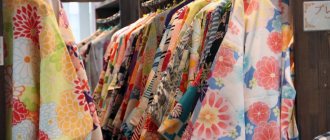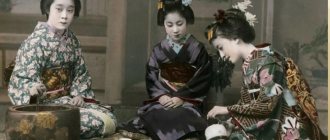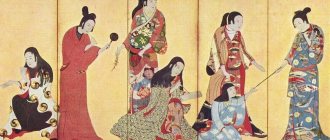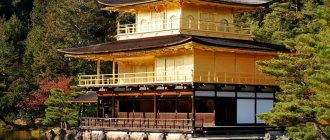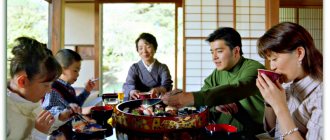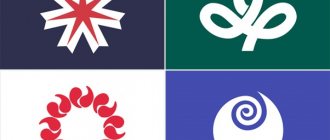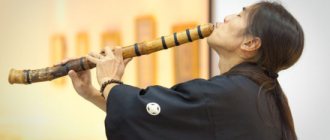Quote from Kapochka_Kapa's message
Read in full In your quotation book or community!
Traditional Japanese clothing.
The Japanese national costume has a long history.
The main attributes of traditional clothing are geta, kimono, hakama and netski.
In the Japanese language, kimono, and in the broad sense of the word means “clothing”, more precisely, national clothing, in contrast to European, which is called “yofuku”, is a collective concept; there are several varieties of them: firstly, for men and women, and secondly , upper ones (which, in turn, are divided into kimonos with long, up to one and a half meters, sleeves - furisode and with short ones - kosode) and lower ones, as well as home and sleeping ones - yukata.
In modern Japanese, there are three words for Japanese traditional clothing: 1. kimono (着物) - outfit 2. wafuku (和服) - Japanese clothing 3. gofuku (呉服) - “Chinese” clothing
The oldest of them is the first option. By the beginning of the Westernization of Japan in the mid-19th century, it was used to designate any clothing. Back in the 16th century, Portuguese Jesuit missionaries reported in reports to Europe that the Japanese called clothing the word kimono. This name has migrated to most foreign languages, including Russian. Although in pre-modern Japan "kimono" was an analogue of the universal concept of "clothing", in Europe and America it became associated specifically with Japanese attire. At the end of the 19th century in Japan, the number of people who began to wear Western-style clothing increased. The difference between Western and Japanese costume forced the Japanese to distinguish the latter from the general concept of “kimono”. A neologism arose to denote traditional clothing - “wafuku”. Until the end of World War II, this word became the main word for defining Japanese attire. However, in post-war times, under the influence of the American “understanding” of Japanese reality, the universal term “kimono” began to be used as one of the synonyms of “wafuku”.
Kimono
Accordingly, in modern Japanese, “kimono” has two meanings. In a broad sense, it is a general term for any clothing, and in a narrow sense, it is a type of wafuku. Archaeological finds in the Japanese archipelago support the thesis that the earliest Japanese wore simple hemp clothing at the end of the Jomon era. At the beginning of the 1st millennium BC. e., under the influence of continental fashion, a Korean-Manchu type suit came to Japan. The earliest kimonos, which appeared around the fifth century AD, were very similar to hanfu, traditional Chinese clothing. In the eighth century, Chinese fashion made the collar collar part of modern women's clothing. During the Heian era (794–1192), the kimono became highly stylized, although many still wore a mo train over it. During the Muromachi era (1392-1573), the kosode - kimono, previously considered underwear, began to be worn without hakama pants over it, so the kosode had an obi belt. During the Edo era (1603-1867), sleeves grew in length, becoming especially elongated for unmarried women. The obi became wider, and different ways of tying the belt appeared. Since that time, the shape of the kimono has remained almost unchanged. The revolution in Japanese clothing was brought about by the Westernization reforms of the Meiji period in the second half of the 19th century. European fashion began to supplant Japanese traditional costume. This process was gradual and superficial until 1945, affecting only the leading layers of society. However, the democratization and “Americanization” of the lifestyle of ordinary Japanese led to the fact that the Japanese kimono was forced out of everyday life. Today, Japanese traditional costume is used mainly only during holidays and formal events.
Features of kimono
The kimono resembles a T-shaped robe. Its length may vary. Clothing is secured to the body with an obi (帯) belt, which is located at the waist. Instead of European buttons, straps and twine are used. A characteristic feature of the kimono is the sode (袖) sleeves, which are usually much wider than the thickness of the arm. They have a bag-like shape. The sleeve opening is always less than the height of the sleeve itself. Because Japanese traditional attire is robe-like, it does not have an open collar like European suits. In general, it is comfortable and does not hinder human movements. The fabrics from which kimonos are made are generally inelastic. Cloth is used for the belt. Patterns for clothing are usually rectangular and differ from their European counterparts in their complex rounded shapes. Thanks to this, savings and almost complete recycling of matter are achieved. Its rectangular remains can be reused on the farm. For sewing kimonos, predominantly soft threads are used, which reduce the risk of fabric tugging. However, such careful treatment of material, which was scarce in traditional Japan, negatively affects the preservation of the design of the clothing. If it is damaged, the kimono can be remade from the same fabric.
Kimono and Japanese aesthetics
Unlike traditional European clothing, which emphasizes the structure of the human body, a kimono highlights only the shoulders and waist of the wearer, hiding the flaws of his figure.
Western clothing emphasizes relief, while Japanese clothing emphasizes uniformity and flatness. This is due to the traditional Japanese idea of an ideal constitution - “the fewer bulges and irregularities, the more beautiful.” For example, in Europe, women's corsets were used to narrow the waist, and to look beautiful in a kimono, the “ideal figure” was not enough. The “ideal face” and makeup were considered an integral part of the ambiance. In the late Middle Ages, the standard of the “Japanese beauty” was established. The face should have been flat, and its oval should have been elongated. Slanted eyes with narrow and high eyebrows were considered beautiful. The mouth was supposed to be small and resemble a small red flower. Only the nose protruded relatively strongly from the low-profile face. A woman’s skin had to be as white as snow, which is why Japanese women have long whitened their faces and other body parts protruding from under the kimono. This ideal of a beauty is successfully depicted in Japanese prints of the 17th-19th centuries. Production
Men's kimonos come in different sizes, while women's kimonos are generally the same size and are adjusted using pleats. An ideal kimono has sleeves that end at the wrist. A man's kimono should fall to the elbow without forming folds. Women's kimono are longer to allow for ohashori, a special fold that peeks out from under the obi. Very tall or overweight people, such as sumo wrestlers, order a kimono for themselves, although there is usually a whole piece of fabric left in the finished product, with which it can be easily altered to almost any figure. A kimono is made from a single piece of fabric. A piece of fabric is usually about forty centimeters wide and eleven and a half meters long. This is enough to sew one kimono for an adult. The finished kimono contains four strips of fabric: two of them cover the body, and the remaining ones are used to form sleeves; in addition, additional strips are used for the collar, etc. In the past, kimonos were often ripped open before washing and sewn by hand afterwards. The traditional kimono is made by hand, and the fabric is also often made and painted by hand. Repeating patterns are applied in this case using a stencil. Over the years, many trends have changed in the style of kimono, accessories, type and color of fabric. Kimonos and obi are traditionally made from silk, crepe silk, satin; modern kimonos are made from cheaper and more practical material, crepe satin, cotton, polyester and other synthetic threads. Silk is still considered the ideal material needed in formal settings. Typically, woven patterns or small designs are worn in informal situations; in kimonos for formal situations, the designer's design runs along the hem or across the entire surface. In the Heian era, up to ten contrasting layers of clothing were worn under a kimono, and each color combination was strictly defined. Today, under a kimono, they most often wear another, thin one. By the pattern you can determine the season it is worn, for example, a pattern with butterflies or cherry blossoms will be worn in the spring, water patterns are common for summer, Japanese maple leaves are a popular autumn motif, and colors with pine trees and bamboo are suitable for winter. Old kimonos are recycled in many ways, they are used to make haori and kimonos for children, they repair similar kimonos, and they are used to make bags or accessories. A kimono with a damaged bottom is worn under the hakama to hide the bottom. Experienced textile workers used to remove threads from kimonos and reuse them into fabrics.
In principle, they are all a straight-cut robe with wide sleeves, wrapped around the chest on the right side, for both men and women. The left side of the kimono is wrapped only on the deceased before burial. Men secure the kimono with a belt at the hips, tying a knot on the right or back. Women's belts - obi - are located at the waist and above it and are tied with a wide, fluffy bow at the back. At first, the townspeople were forbidden to wear clothes made from expensive fabrics of bright colors, but, smart and resourceful, they learned to deftly circumvent these prohibitions. An inconspicuous and even shabby kimono made of simple fabric could have a luxurious brocade lining. The rich artisan wore several other, expensive and beautiful ones under a modest outer dress. At the same time, this ban gave impetus to the emergence and development of specifically Japanese aesthetics. They began to find beauty and charm in the simple and discreet. A good kimono is very expensive. The material for it is usually woven and painted by hand. In this case, a gimp made of silver and gold is used, and when dyeing, a powder of gold and silver powders is used.
Only a master can sew a ceremonial kimono: it is necessary to select pieces of fabric so that the pattern organically flows from the back to the chest and sleeves and creates the impression that this is not just clothing, but something more - a complete work of art. Precious ancient examples of kimono take pride of place in museums and are carefully kept in families, passed down from generation to generation.
Only very rich people, as well as actors of traditional Noh and Kabuki theaters, for whom the kimono is a stage costume, are paid a state subsidy for its purchase.
Dress kimonos are made from standard pieces of fabric, so they are all approximately the same size. A Japanese woman can wear a kimono purchased in childhood for the rest of her life and then pass it on to her daughter or granddaughter. The length is adjusted by picking up the excess under the belt, and then releasing it as the owner grows.
Homemade kimonos - yukata - are sewn with approximate height taken into account.
An important detail of a traditional outfit is the obi belt. It gives the kimono completeness and massiveness. As a rule, a special piece of brocade or thick silk, four meters long, is woven for the belt, with a particularly rich pattern at the front, where the belt fits tightly to the figure, and at the back, where it is tied with an intricate knot. There are several ways to tie a belt. In earlier times, the shape of the knot indicated the class of a Japanese woman, but now it depends only on her taste and skill. The length of the kimono varies depending on the situation. There are different sizes for men, but one universal size for women. It is adjusted to the figure by forming additional folds. Fastened at the waist with an obi belt.
A special feature of the kimono is its very wide sleeves - sode . The length of the sleeves of a Japanese kimono depends on their marital status; unmarried women have longer sleeves. The girls' outfit is much more lavishly decorated than a similar outfit for a married woman. Silk is considered ideal for a kimono, but cheaper materials such as crepe-satin, cotton, polyester, and crepe-silk are also used.
The ornament and design of the outfit depends on the time of year, the event and the status of the person. On a classic kimono, the design on silk is applied by hand. From the middle of the 19th century it received the status of “national costume”. Today it is used mainly during holidays, festivals and official events.
The decor of a kimono is always associated with the seasons and reflects the poetry and symbolism of natural phenomena.
Most often, the national costume is worn in connection with festive and special events. Elegant, bright kimonos with fur trim at the collar can be seen on modern girls on New Year's Day. The same beautiful kimono, but without fur, is worn by many to the official ceremony on Coming of Age Day, which is celebrated in January by 20-year-old Japanese.
The process of putting on a real kimono is a kind of creative act that reveals not a person’s figure, but the features of his character. The kimono wraps tightly around the body, instilling patience and submissiveness. Long hemlines, wide sleeves and a tightly tightened belt change a person’s movements, making them leisurely and soft, like a cat’s.
Wearing a kimono is a special science. The back is straight, the chin is slightly tucked in, and the shoulders are relaxed. Movements should not be sweeping or abrupt.
playlist
Under no circumstances, even by accident, should you show legs or other parts of the body hidden under clothing. This is not appropriate. The wisdom of this rule lies in the fact that it equalizes young and old women, hiding the faded beauty of the latter and the attractiveness of the former.
The Japanese believe that a woman acquires a different beauty over the years, and the kimono becomes a wonderful shell for this chest of spirituality.
According to tradition, the art of dressing a kimono is passed down from mother to daughter, but in modern Japan, specialized kimono schools are engaged in preserving this ancient tradition, which provide various courses for mastering the difficult science of dressing a kimono.
Yukata
Summer light cotton kimono with a printed pattern. Yukata is worn by both women and men. This is the simplest of all kimonos.
Furisode
— a girl’s festive kimono. Previously, furisode could only be worn by a virgin or a girl under 20 years old, after which it was necessary to change the type of kimono. In modern society, furisode is the clothing of unmarried girls, regardless of age.
Ushikake
- wedding cape
Today's ushikake ( uchikake, uchikake ) is a luxurious long cape worn over a kimono, trimmed along the bottom with a roll of scarlet (less often gold) fabric to glide more gracefully across the floor. Currently, the term "ushikake" is only used for the bride's outer kimono. Before the Edo era, ushikake was worn as casual and formal wear (depending on the decoration and material) by nobles and women from samurai families. At the end of the 19th century, ushikake also began to be called the outer kimono worn at the wedding ceremony. Ushikake is made of brocade or silk, lined with cotton wool, has long sleeves (more than 1 meter), is not tied with a belt, is not tucked, using the entire length of the dress.
Kimono TchiTchi & Martin Wedding
Ushikake wedding cape
with peacocks on a pine tree.
In ancient times, a kimono could be tied with a belt, picked up, and several ushikake could be worn at once. There were also male varieties of ushikake, not inferior to female ones in the splendor and brightness of their decor. Such costumes were worn by courtiers or at receptions in the imperial palace until 1870.
Tomesode - married woman's kimono
A strict short-sleeved kimono, usually black, with a wide patterned stripe along the hem and five family coats of arms. It is worn at family formal celebrations. Colored tomesode
called “iro-tomesode”, it is less strict and solemn
Other clothing accessories
Japanese women do not wear hats. A beautiful high hairstyle or a chic head of hair is considered a decoration. Hakama are long trousers. First appearing in the 6th century, they were originally a piece of cloth wrapped around the hips. Over time, they transformed into long pants with pleats, similar to a skirt. Worn by men in informal settings or as a uniform in some martial arts. Netsuke (netsuke) is a detail of the Japanese national costume, it is a carved keychain. The kimono has no pockets; containers for carrying keys and a pouch were attached to the belt using a hanging netsuke keychain. At the same time, it served as a decoration for the outfit. A wide variety of materials are used to make netski: wood, ivory and walrus ivory, deer and buffalo antlers, bear, wolf and tiger fangs. Geta are traditional wooden sandals worn by men and women. Susoyoke is an underskirt worn under a kimono.
Haori-himo is a woven strap used to tie a haori. It is usually white in color. Nagajuban - is a lower kimono, it is shorter than the upper one and is used as underwear. A special thin shirt is worn under it - Hadajuban, which separated the expensive silk fabric from the body. The sleeves of the lower kimono are longer than those of the upper one, and the cuffs are made of more expensive material. The collars were made interchangeable. Hakama are pleated wide pants used in certain types of martial arts. Haori is an outer covering usually worn by men and extending to the hips. For women, the haori is usually longer. Hiyoku is an underwear kimono worn at weddings and other social events. Junihitoe is a complex kimono consisting of 12 layers. It was usually worn by court ladies. Now such clothes can only be seen at an imperial wedding or enthronement ceremony. Kanzashi - a variety of jewelry designed for traditional hairstyles. These could be silk flowers, wooden combs or jade pins.
Geta
Geta is the national shoe of Japan. Wooden sandals shaped like a bench on two legs. The height varies depending on the purpose, reaching 10-15 cm. Gete are secured to the leg with two laces. Women's ones are decorated with bells, beads, brocade, and sequins. The value of men's shoes is determined by the type of wood used for manufacturing and the fineness of the carving applied.
In general, national Japanese shoes are not very comfortable. For example, “geta”, wooden sandals with two high heels. In geta, it’s good to walk through puddles, waddling from heel to heel and with these movements reminiscent of a heron, but you won’t be able to chase a departing bus in them. But “geta”, like “zori”, is very easy to throw off when coming into the house. In short, its national footwear has not found distribution anywhere outside of Japan.
A century ago, geta were usually made of wood. But, despite the seemingly banality of its forms, geta had many features. And today they can indicate the social status or occupation of the owner. Thus, an observant eye can notice the difference between the very strictly quadrangular geta (kaku geta), which is usually worn by middle-aged men, and the geta with rounded corners, used by elderly men or clergy. Some can even recognize the nomeri geta (forward bending gag) that are popular among performers.
It goes without saying that, depending on belonging to different classes and seasons, the getas had different decorations. Thus, men's geta were partly inferior to women's in aesthetics, but they attached significant importance to the type of wood used, skillful carving and varnishing applied to the surface. Women's ceremonial dresses were covered with gilded brocade and looked more like slates, although in winter, especially in snowy areas, they were made higher than usual. Moreover, female geta specifically indicate the age of their owner. True, now with business clothes most women choose to wear soft sandals made of fabric with an insole - zori.
Zori - sandals without heels, but with a thickening at the heel. Favorite shoes for everyday life and an indispensable attribute of the national holiday costume. The zori are held on their feet by straps that pass between the big and second toes. Unlike geta, they are made separately for the right and left legs. They are made of leather, straw, synthetic materials (including vinyl, which makes the shoes even softer and more comfortable). And although it is not so common to hear the shuffling sounds of the famous geta in today's Japanese metropolis, they remain to this day an undoubted attribute of traditional Japanese clothing, which was still used during the coming of age ceremony (after reaching the age of 20), marriage , as well as geishas and other representatives of the art world who dress in kimonos.
Obi(belt)
Obi
(Japanese 帯?, lit. "belt") - several different types of Japanese belts worn by both men and women over the kimono and keikogi.
Male
obi, as well as obi for martial arts, is relatively simple and narrow, no more than 10 centimeters in width, and is tied with a simple knot.
Female
The obi reaches 30 centimeters in width and 4 meters in length, is tied with an elaborate large decorative bow at the back, and usually costs more than the kimono itself. There are complex rules of etiquette about which obi can be worn in which situations, and with what bow they should be tied.
Features of development
The actors of the well-known Japanese Kabuki theater are considered to be trendsetters in Japan. It was they who had to constantly modify their costumes in order to choose the most suitable option for creating a particular stage image. People who came to the performances noticed the new elements that the clothes had at that moment and began to apply them in everyday life.
Traditional clothing in Japan developed largely thanks to peasants . This is due to the fact that representatives of the aristocracy wore outfits in a stylistic direction adopted from China and Korea. Several centuries later, the robe in Japan, known as a kimono, began to be worn by all citizens of the country, regardless of status and financial situation.
Japan was constantly developing and this obviously could not but affect its folk clothing. All of it began to be divided into female and male. Initially, traditional Japanese clothing was universal. Mo skirts and hakama pants appeared. True, this innovation caused misunderstanding on the part of residents of the state. They had to come to terms with these changes only after the corresponding decree was issued by the emperor himself.
Samurai clothing
Instead of pants, samurai wore trousers - nagabakama, which were wide and long, which did not restrict movement and ensured a lightning-fast reaction in the event of an attempt on the life of the ruler. After all, samurai in Japan were considered bodyguard warriors who served their masters. Samurai dressed differently than ordinary people in Japan. He wore a pair of swords in a wide belt, and his clothes had a special cut (reifuku). Everyday he wore wide hakama pants, a kimono with short sleeves (kosode) and an outer kimono. On top was a haori - a cape with short sleeves. It was forbidden for ordinary Japanese to wear samurai clothes. For violating this rule one could lose one's head. The samurai's clothes were sewn with family crests in five places. Only rulers and samurai had coats of arms. Coats of arms were not sewn on hakama, since such clothes could be worn by ordinary Japanese - artisans and traders.
Japanese warriors wore armor in the form of all-metal breast plates, which essentially played the role of a modern body armor. And his head was covered by a metal helmet. With the improvement of steel processing technologies, the armor of the Japanese warrior also changed. The Heian and Kamakura eras became the peak in the creation of weapons and the period of the birth of the samurai. Since then, little has changed and has survived to this day.
The samurai wore his armor only before battle or on special occasions. They took great care of their weapons and armor. Swords had their own names and were passed down as the greatest family value from generation to generation.
Characteristics
Japanese women in this state had a special purpose. Women were supposed to evoke admiration from men, please them and, of course, give aesthetic pleasure. Thanks to the kimono, geisha could emphasize the advantages of their figure, look defenseless and incredibly graceful .
The men's suit was created according to a completely different principle. He was non-staining, extremely practical and quite strict. That is why dark, restrained shades were used when creating the national costume. True, there were also patterns. It was geometry that became popular. Quite rare, but there were also plant motifs, and there were images of birds, fish and various animals.
Women's, as well as men's, Japanese national costume, intended for festive events, had a chic appearance. When designing it, the brightest colors were used, which harmoniously combine with each other.
Naturally, Japanese costumes differed depending on the season. For example, Japanese girls wore outfits with maple leaves in the autumn. In spring, sakura was featured on national clothing. In winter, matzo pine needles were used as a print on the costume.
Ganguro
Decora
Kawaii
Ko Gal
Cosplay
Lolita
visual kei
Harajuku
Existing varieties
Folk clothing has a number of differences taking into account gender, as well as the status and position of people in society.
Japanese clothing for women is designed in a rather clever and seductive way. The folk outfit turns out to be multi-layered. The Japanese woman's costume has a design where, as if by chance, the lower parts are revealed in certain places. It is due to this that the image turns out to be more sexy.
Skirts called koshimaki and futano are used as lower national clothing. In addition, a body type shirt called hadajuban is also used. These details of the traditional costume are selected in such a way that the color matches harmoniously with the kimono.
Not a single Japanese national costume can do without an obi belt. Its distinctive feature is its enormous length. The traditional version reaches five meters. Thanks to such a long length, girls can tie truly delightful, extraordinary bows. Obi could have very diverse shades. It was often decorated with ornaments. True, they performed not only an aesthetic role. From this drawing one could find out the social status and marital status of a woman.
Payment:
Dear customers! You can pay for your order using a bank card or from an email account through the most secure PayPal system, without disclosing your credit card information.
The store's main currency is the Japanese yen. The price in rubles, dollars or euros is displayed as a reference for the convenience of buyers and is indicative. You can check the conversion rate for the international payment system PayPal before purchasing on the official website.
Product prices shown on the website do not include shipping costs from Japan.
Processing and order processing times:
The time it takes to prepare an order for shipment is about 2-10 days. In some cases, the processing time for a parcel may take a longer period.
Delivery:
We deliver all goods directly from Japan to any country in the world where the postal service from Japan is available, in the following ways:
- EMS is an express service (about 5-10 days in transit), the parcel is received by courier at the specified address. The investment is insured.
- AIR (on the way about 1.5 - 2 weeks), the parcel is received by the customer himself using his passport at the nearest post office. The investment is not insured in case of loss of the parcel.
- SAL is a low-cost international air delivery service (the journey takes about 2-4 weeks), the parcel is received at the post office independently by the customer using his passport. The investment is not insured in case of loss of the parcel.
Immediately after the order has been dispatched, we will send your postal identification number by email.
Important: after the parcel arrives at the nearest post office in your area, it will only wait for you there for 1 month. After this period, the parcel is returned to the sender. In this case, the money will be refunded to the buyer's account after the parcel returns to Japan (excluding the amount for shipping and bank transfer fees).
Please note that our store is not responsible for possible additional delay of the parcel in the event of a random, more thorough check at customs.
Return Policy:
If you decide to return the product, please notify us by sending an email to the store. The email address is being protected from spambots. To view the address, Javascript must be enabled in your browser. The product is accepted back if you wrote about your desire to return it no later than 7 days from the date of receipt, and sent the parcel back no later than 2 weeks from the date of its receipt. In this case, the money will be refunded to the buyer's account immediately after the package is returned to our office in Japan (excluding postage fees, bank transfer fees and the cost of damaged products).
If an order is returned due to the customer's fault (the parcel was not in demand, failure to appear at customs if necessary, etc.), responsibility for paying fines and the cost of return shipping falls on the customer.
If an error occurs due to the fault of our store (for example, the product range does not match your order), the full cost of the product and the cost of return shipping will be returned to the buyer's account after the product is returned to our office. Or the goods will be exchanged by mutual agreement.
Please note that the colors in the product photos may differ slightly from the original ones. If an item is returned due to a color mismatch, all return costs will be the responsibility of the customer.
Traditional women's shoes
The Japanese costume includes very specific shoes, which may seem uncomfortable to residents of European countries. Among the most popular national models are geta and zori. The features of each of them should be considered in detail.
Dzori were intended for peasant women. Naturally, the shoes were very simple and far from the most attractive. It was an oversized woven sandal equipped with a sole.
Only rich women and geishas could wear geta. These national shoes come in two varieties. In the first case, it is equipped with a massive wooden block, in the lower part of which there is a recess. In the second it is a kind of bench. It is also made of wood. The platform could be a maximum of ten centimeters in height. To keep the shoes securely on the foot, laces were used. They were secured between the thumb and index finger.
The most talented artists were involved in the production of geta. They decorated shoes with extraordinary paintings. Many of these national products are now in museums. This is due to their incredibly attractive appearance. Art connoisseurs often call them a strong rival even to famous paintings.
Japanese national costume
The kimono is made from straight panels of fabric that are thrown over the shoulders and connected in the middle at the back with a seam. The panels are sewn on the sides, and the sleeves are sewn into the wide armholes. Sleeves are often much wider than the armhole, and then the rest of them are sewn together at the edges. The lower part of the sleeves is sewn on three sides and is a kind of hanging pockets that the Japanese use for small items. The kimono has no fasteners, it wraps from left to right and is tied at the hips with an obi belt. Obis were worn on all occasions - in everyday life, in formal settings, on holidays. Haori is another type of Japanese shoulder-length outerwear. This is a fairly short, straight, swinging jacket with wide rectangular sleeves and a stand-up collar. Unlike a kimono, the haori is not wrapped, but is connected at the front using ribbons that are tied in a bow. The upper waist garment for men is the hakama, wide and long, reaching to the ankles, resembling a culotte skirt with rigid pleats in front and back. These pants had side slits from the waist to the hips, and both sides were sewn onto two waistbands with long ties. The formal and ceremonial Japanese men's costume (“reifuku”) has been preserved almost unchanged from the times of feudalism to the present day. It consists of a kimono, over which hakama and haori are worn. In a traditional Japanese suit there are no pockets, and men attached a wallet, a snuff-box, a pipe, and various small things with the help of netsuke to the belt with a cord. A netsuke is a keychain that was originally shaped like a button or stick, and then turned into a miniature sculpture made of wood or bone, about three centimeters in size.
Woman suit
The traditional costume of Japanese women consisted of lower and outer clothing. The lower waist garments were “futano” and “koshimaki” skirts. Futano is a short unstitched skirt made of bleached cotton fabric; koshimaki is a long unstitched skirt made of more expensive fabric (it is visible when the kimono opens). Japanese women also wore lower shoulder clothing - "hadajuban" shirts made of light silk or cotton fabric. Unlike the men's juban, this women's shirt did not have sewn up the lower part of the armhole and the sleeves in the armpit area. The main types of women's outerwear, preserved almost unchanged, were kimono and haori. In shape and cut they were the same as men's, differing only in the unsewn armhole and sleeves in the armpit area. The kimono was girded with a very wide obi belt, which was wrapped around the waist several times. At first it was tied with a beautiful bow at the front, but later the bow was moved to the back (like the bustle of European ladies). The obi, the main decoration of a woman’s dress, was made of silk or brocade with a beautiful complex pattern. Women's haori was worn both when going out and every day. Everyday was usually shorter. There was a type of haori - “nenneko”, which women wore when carrying a child on their back. The sleeves in nenneko were completely sewn into the armhole. From the end of the 12th century. women's costume is simplified. From the 16th century Japanese women wear kosode, a long, straight dress with a small neckline and short sleeves. It could be silk, quilted or wadding, and was always worn with an obi belt. Initially it was underwear, but then kosode became an elegant outer dress. It was made from expensive fabrics, decorated with gold and embroidery, with large ornaments that could be located spirally, diagonally or asymmetrically along the surface of the dress. The shape of this clothing remained unchanged for centuries.
on a man: double kimono, pants tied with straps, geta shoes
on a woman: a kimono with a fluffy obi, a complex hairstyle with decorative pins
On a woman: a kimono with a wave-like pattern, a long obi belt, zori shoes
On a man: hakama and outer kimono
Shoes
Traditional Japanese shoes are “geta” and “zori”, which are still popular in Japan today. There were two types of geta. One of them is a wooden shoe that looks like a bench with two heeled legs about 10 centimeters high. When the Japanese collected seaweed from the sea or fruit from trees, they wore geta with the highest heels. Another type is wooden lasts, which have a flat sole on top and a notch on the bottom in the middle; the toe is bent at an acute angle. Geta were attached to the leg with two cords or straps. The second traditional type of Japanese zori shoes is woven sandals. They were made from reed, bamboo, and rice straw. Zori have a flat sole, no heels and only one size. Along with geta and zori, the Japanese wore peculiar socks - “tabi” with thickened soles and a separately cut toe. They were made of white linen or silk and fastened with hooks along the ankles. The Japanese still wear white or colored knitted tabi.
Hairstyles and hats
Men's hairstyles had strict social gradations. For violating it, the offender was punished. A headdress is not a necessary element of traditional Japanese costume. But it complements ceremonial and ritual costumes. For representatives of the Japanese nobility, the ceremonial headdress did not so much protect the head as it had a symbolic meaning. Women in ancient Japan wore long, flowing hair that could be tied in a bun. In the XIV-XVI centuries. Japanese women's hairstyle becomes very complex, requiring many combs and pins. For stability, pillows and velvet rollers were placed in high hairstyles, and hair was wound on oval combs. This hairstyle was styled once a week and covered with oil or wax to make the hair shiny. Japanese geishas wore a special hairstyle: the hair on the back of the head formed a puff, the neck was bare, which was emphasized by a special collar. Geishas decorated their hair with pins with tiny fans or paper flowers at the end.
Jewelry and cosmetics
Japanese women have been decorating themselves with cosmetics since ancient times. They rubbed their bodies with red powder, applied a thick layer of whitewash to their faces, blackened their teeth and shaved their eyebrows. Married women drew two stripes high on their foreheads with ink. All this gave women's faces mystery and enigma. Women and men decorated themselves with gold and bronze bracelets, earrings, necklaces, rings, and pendants. They wore beads made of jade, jasper, rock crystal, pearls, and agate. The ancient Japanese used mirrors and wore bronze or gold-plated belts and buckles. Women decorated their hair with beautiful tortoiseshell, wood, coral, bone combs and pins. The men's suit was decorated with weapons worn at the belt. Since ancient times, a traditional addition to Japanese costume has been a fan. There were two types of fans - folding and non-folding (in the form of a fan). Source - “History in costumes. From Pharaoh to Dandy." Author - Anna Blaze, artist - Daria Chaltykyan.
Accessories
To make women in national clothes look as elegant and attractive as possible, the image was complemented with the help of accessories. Folk decorations were not very diverse, but they still existed. Most often they resorted to using the following:
- netsuke. These are a kind of key rings that are fixed on the belt;
- hairpins, sticks and combs. Used to create hairstyles;
- fans.
It is with the help of such details that Japanese national clothing becomes even more recognizable and colorful.
Samurai outfit
A Japanese men's suit, designed for a samurai, is considered an indicator of courage and bravery. It was a kind of dress that only representatives of this class could wear. If commoners appeared in such attire, they were subjected to severe punishment. True, on holidays the emperor still allowed artisans to wear hakama. These are pleated trousers that are visually similar to a skirt.
Men's Japanese samurai clothing includes a pair of kimonos. The bottom one is made in a snow-white shade. On the top there were family coats of arms, which indicated which family the samurai came from.
Clothing of feudal lords in Japan
The first picture shows Sokutai's clothing - a ceremonial dress that a nobleman wore to a reception with the ruler. Women's formal dress is shown in Figures 2 and 6. Men's home suit is shown in Figure 3, and women's home attire can be seen in Figures 4 and 5.
Children's kimonos
National Japanese clothing intended for girls is in many ways similar to that for adults, but much more elegant and elaborate. The colors applied are incredibly picturesque. The prints in this case are very specific and carry a special meaning. It is believed that with their help the child attracts good luck.
Among the most popular images are koi carps. Numerous legends are associated with them. It is not surprising that such a design has become one of the main symbols that adorns the national clothing of Japan.
Types of Japanese national clothing Kimono
Since the middle of the 20th century, culture from Europe and America began to penetrate into Japan. The national costume was replaced by ordinary clothes. At first, it began to be worn by the upper class, and since 1945, the American style has taken over the countries of the East.
Today, the kimono has become more of a festive costume; on weekdays it is most often worn by elderly Japanese women. Tight-fitting and covering all parts of the body, the kimono calls for submission and humility.
The kimono is the national costume for all Japanese, regardless of gender and age. It is made from a single piece of fabric. To sew a women's kimono, you need from 9 to 12 meters of fabric. A real kimono must be made by hand, and the repeating pattern must be applied using a stencil.
Any suit, regardless of who is wearing it, should be wrapped only from left to right. The suit is wrapped in reverse only on the deceased during burial. A special belt, called an obi, is tied at the waist over the kimono. The kimono has numerous straps and cords instead of buttons, and netsuke are hung as decoration.
A women's suit differs from a men's kimono in the number of parts, there are 12 in total, so it is almost impossible for a woman to get dressed without outside help. The kimono for men is simpler, consists of five parts and has shorter sleeves.
When choosing a kimono, they take into account the gender of the person, the event (wedding, funeral, etc.), the time of year, a living person or a deceased person, age, and status in society.
Keikogi
For a long time throughout the former USSR, the national keikogi training suits were called “kimonos,” which is fundamentally wrong. Consisting of an outer jacket and loose pants, the suit was intended for meditation, martial arts classes and morning walks, including running.
With the development of various martial arts schools and the emergence of completely new techniques, keikogi were modernized and adjusted to specific types of combat. Only one detail of the keikogi remained unchanged - the belt. It is a long, up to 4 meters, piece of fabric, folded and stitched lengthwise and crosswise several times.
Tying a belt is a full-fledged ritual. Under no circumstances, even with minor training, should you wrap it around the navel - according to most teachings, this area is the point of concentration of the male energy of the body. The belt should be placed on the hip bones. This was also done for reasons of convenience - so that nothing would interfere with meditation.
In Japan itself, keikogi is also called “dogi”. This is where a whole series of names related to specific types of martial arts came from - karategi, aikidogi, judogi and so on. In modern Russia, all these costumes are still called the general word “kimono,” although with a reservation for each martial art.
Keikogi
Obi
Obi is a general word for a range of sashes that are worn over the traditional kimono and other traditional clothing of Japan. There are several dozen types of men's and women's obi belts, but the main types can be divided into small groups.
The hard maru obi is considered an archaic type of belt that women wore only for ceremonial receptions and meetings. It is embroidered on both sides with expensive threads and decorated with inserts of brocade and other types of expensive fabric. A mandatory element is an obi-makure hairpin, usually made of precious metals.
A less elaborate fukuro-obi belt is decorated with expensive elements on only one side. It is considered a modern version of maru, so today such belts are found much more often in Japanese stores.
Nagoya-obi and hanhaba-obi are types of belts that appeared already in the 20th century. The first option has a wide central part, while the ties differ little from men's sports belts. The designs on both options are more modest compared to maru.
Important: The classic women's obi belt is 4 meters long and has a minimum width of 30 centimeters. Due to the huge amount of fabric used to make it, the price of such a belt, even in modern conditions, is enormous. Very often the belt costs 2-3 times more than the kimono itself.
Hakama
Hakama are traditional Japanese pants, often used as the main props for filming films about Japan. By the way, hakama does not always appear in the frame with the proper level of historical accuracy.
In the Middle Ages, only samurai and high aristocrats had the right to wear hakama, and commoners could wear such pants only once in their life - at their own wedding. Over time, women's versions of the hakama also appeared, which at first glance cannot be distinguished from a long ruffled skirt.
Today, you rarely see hakama in everyday wear, especially on men who are accustomed to more practical trousers and jeans. However, a similar cut of pants is found in the aikidogi costume, as well as in the graduation uniform of students at several prestigious Japanese universities.
Hakama
Yukata
The lightweight yukata kimono was originally invented for women to wear after bathing. A robe made from linen or fine cotton was supposed to serve as a towel, perfectly absorbing moisture before changing clothes. But over time, the purpose of this element of Japanese clothing has changed.
Now not only women, but also men have the right to wear it. The yukata will differ only in color - for men it is more strict. Otherwise, yukata in Japan can be worn as a robe or a light summer dress. Although, the last option is still more suitable for girls.
School uniform
The Japanese school uniform deserves special attention. There are no strict rules in junior school. Children are simply not forced to wear a certain outfit. You only need to adhere to the traditional rules that the official style implies. During this period, little Japanese women wear light blouses and long sweaters that reach the knee. Boys wear white shirts and shorts made in blue or black.
Things are completely different in high school. During this period, the Japanese form underwent significant changes. Guys have to wear wardrobe items in a military stylistic direction. For girls, sailor suits are provided, which even European students can wear. This form is called gakuran. Translated from Japanese, it means a schoolboy from Europe.
Sailor suit is a Japanese suit made of a pleated skirt and jacket. The top is decorated with a collar made in a marine style. There is a loop on the blouse for a red ribbon. If desired, you can use bows, butterflies and ties instead.
Traditional Japanese clothing is multifaceted and extraordinary. She attracts special attention and simply cannot go unnoticed. It hides a certain mystery, fabulousness and even magic. It is not surprising that the Japanese costume remains in demand even now. Moreover, not only residents of Japan, but also many famous fashion designers show interest in Japanese clothing.
Japanese fashion and style: how girls dress in Japan
When talking about Japanese fashion, the first thing that appears is women in kimonos or Lolita-style outfits, but this is not entirely true. Despite the fact that the kimono is still considered status clothing, you don’t see it as often anymore.
Traditional clothing remains in the wardrobes of Japanese women for serious events. You can see people wearing kimonos at ceremonies such as weddings, funerals, awards processes and tea ceremonies, and are also often worn during holidays such as cherry blossoms and summer fireworks. In expensive Japanese establishments, the staff also often wear kimonos, if it is a traditional Japanese restaurant or resort hotel. The color and fabric of the kimono is selected according to the age and nature of the event.
Gothic style and cosplay can only be seen on certain groups of people on Tokyo's most fashionable street - Harajuku. The Harajuku area is famous for its original street fashion, where young people show off their outrageous outfits, and there are also many shops with unusual cosplay and vintage clothing.
With all the flavor of unique styles, Japan is one of the most fashionable countries in the world. Let's look at the everyday style of Japanese women and their characteristic features:
Restraint in images. In Japan, it is not very common to stand out with brightness; there are many muted colors and achromats, which is considered the most elegant.
They attach great importance to appropriateness , and the Japanese strictly adhere to the dress code. Every profession has a uniform: educators, teachers, waiters and even taxi drivers. Clothes must be appropriate to the situation, thought out to the smallest detail in advance is a distinctive feature of the Japanese.
Minimalism. It is dearly loved in Japan not only in clothing, but also in interior design. Laconic cut, minimum details. Things in a minimalist style can easily be found in Japanese-made departments.
Japanese fashion photos
Read: 165Share the post with your friends
